Public-Private Partnership in Lebanon | Case Study
VerifiedAdded on 2022/08/12
|9
|2059
|23
AI Summary
Question 1 (50 Marks) (Word limit: 750 words) Investment in infrastructure plays a key role in the economy’s potential and ensuring sustainable growth, in addition to improving the living standards of the population. Accordingly, what are the main purposes of public-private partnership allowing to achieve such end result? When such partnership between public and private sectors can lead to collaborative inertia. Support your discussion with reflection on course material, the case, and a tangible example from your national context where public private partnership did not achieve or lead to the desired outcomes. Hint: in your essay, you need to reflect on the following: - Discuss the six bases for collaborative advantage. - Refer to the case and identify which are the main bases that were considered in various PPPs.
Contribute Materials
Your contribution can guide someone’s learning journey. Share your
documents today.

Running head: PUBLIC PRIVATE PARTNERSHIP
Public-Private Partnership in Lebanon Case Study
Name of the Student
Name of the University
Author’s Note:
Public-Private Partnership in Lebanon Case Study
Name of the Student
Name of the University
Author’s Note:
Secure Best Marks with AI Grader
Need help grading? Try our AI Grader for instant feedback on your assignments.
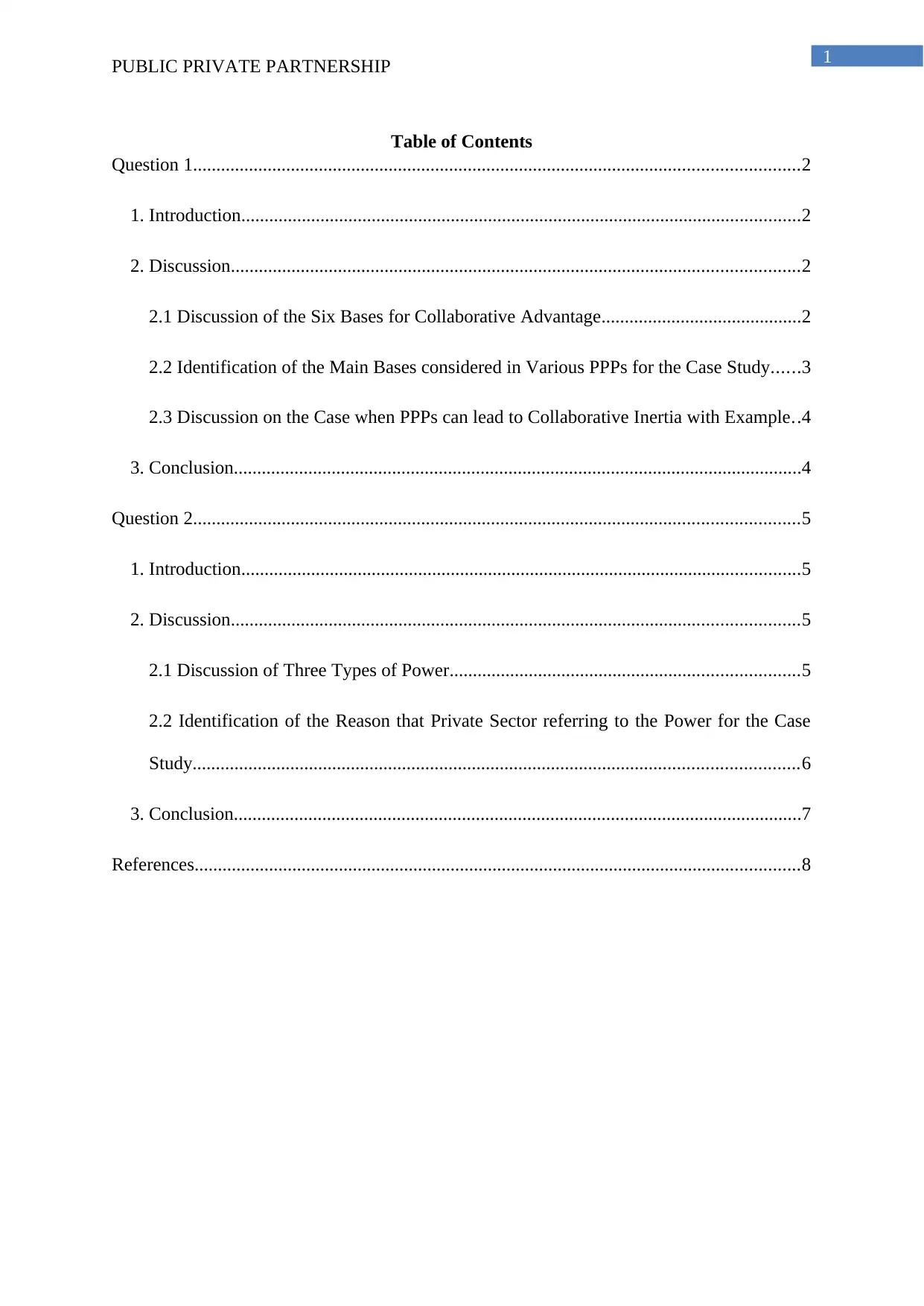
1
PUBLIC PRIVATE PARTNERSHIP
Table of Contents
Question 1..................................................................................................................................2
1. Introduction........................................................................................................................2
2. Discussion..........................................................................................................................2
2.1 Discussion of the Six Bases for Collaborative Advantage...........................................2
2.2 Identification of the Main Bases considered in Various PPPs for the Case Study......3
2.3 Discussion on the Case when PPPs can lead to Collaborative Inertia with Example..4
3. Conclusion..........................................................................................................................4
Question 2..................................................................................................................................5
1. Introduction........................................................................................................................5
2. Discussion..........................................................................................................................5
2.1 Discussion of Three Types of Power...........................................................................5
2.2 Identification of the Reason that Private Sector referring to the Power for the Case
Study..................................................................................................................................6
3. Conclusion..........................................................................................................................7
References..................................................................................................................................8
PUBLIC PRIVATE PARTNERSHIP
Table of Contents
Question 1..................................................................................................................................2
1. Introduction........................................................................................................................2
2. Discussion..........................................................................................................................2
2.1 Discussion of the Six Bases for Collaborative Advantage...........................................2
2.2 Identification of the Main Bases considered in Various PPPs for the Case Study......3
2.3 Discussion on the Case when PPPs can lead to Collaborative Inertia with Example..4
3. Conclusion..........................................................................................................................4
Question 2..................................................................................................................................5
1. Introduction........................................................................................................................5
2. Discussion..........................................................................................................................5
2.1 Discussion of Three Types of Power...........................................................................5
2.2 Identification of the Reason that Private Sector referring to the Power for the Case
Study..................................................................................................................................6
3. Conclusion..........................................................................................................................7
References..................................................................................................................................8
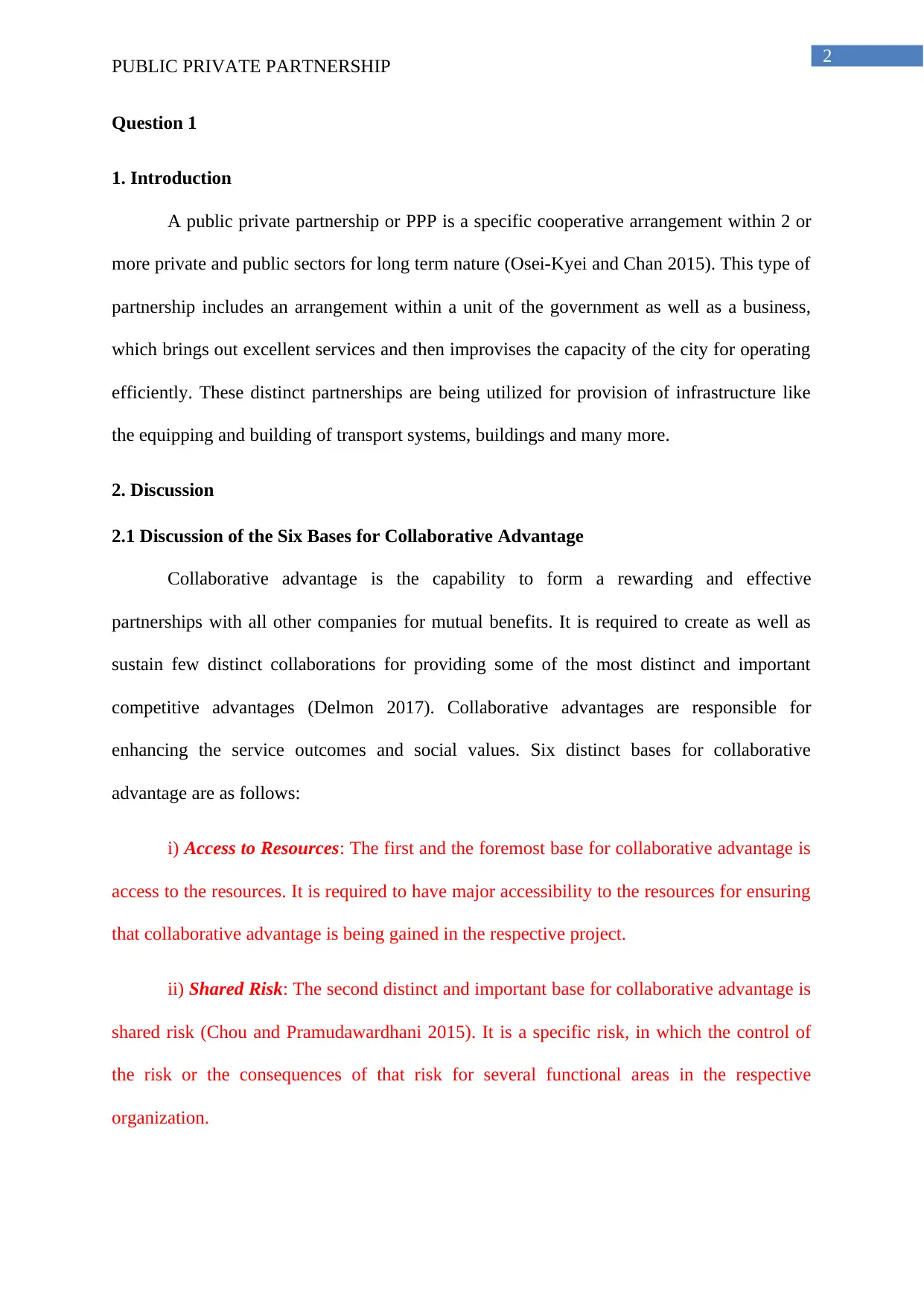
2
PUBLIC PRIVATE PARTNERSHIP
Question 1
1. Introduction
A public private partnership or PPP is a specific cooperative arrangement within 2 or
more private and public sectors for long term nature (Osei-Kyei and Chan 2015). This type of
partnership includes an arrangement within a unit of the government as well as a business,
which brings out excellent services and then improvises the capacity of the city for operating
efficiently. These distinct partnerships are being utilized for provision of infrastructure like
the equipping and building of transport systems, buildings and many more.
2. Discussion
2.1 Discussion of the Six Bases for Collaborative Advantage
Collaborative advantage is the capability to form a rewarding and effective
partnerships with all other companies for mutual benefits. It is required to create as well as
sustain few distinct collaborations for providing some of the most distinct and important
competitive advantages (Delmon 2017). Collaborative advantages are responsible for
enhancing the service outcomes and social values. Six distinct bases for collaborative
advantage are as follows:
i) Access to Resources: The first and the foremost base for collaborative advantage is
access to the resources. It is required to have major accessibility to the resources for ensuring
that collaborative advantage is being gained in the respective project.
ii) Shared Risk: The second distinct and important base for collaborative advantage is
shared risk (Chou and Pramudawardhani 2015). It is a specific risk, in which the control of
the risk or the consequences of that risk for several functional areas in the respective
organization.
PUBLIC PRIVATE PARTNERSHIP
Question 1
1. Introduction
A public private partnership or PPP is a specific cooperative arrangement within 2 or
more private and public sectors for long term nature (Osei-Kyei and Chan 2015). This type of
partnership includes an arrangement within a unit of the government as well as a business,
which brings out excellent services and then improvises the capacity of the city for operating
efficiently. These distinct partnerships are being utilized for provision of infrastructure like
the equipping and building of transport systems, buildings and many more.
2. Discussion
2.1 Discussion of the Six Bases for Collaborative Advantage
Collaborative advantage is the capability to form a rewarding and effective
partnerships with all other companies for mutual benefits. It is required to create as well as
sustain few distinct collaborations for providing some of the most distinct and important
competitive advantages (Delmon 2017). Collaborative advantages are responsible for
enhancing the service outcomes and social values. Six distinct bases for collaborative
advantage are as follows:
i) Access to Resources: The first and the foremost base for collaborative advantage is
access to the resources. It is required to have major accessibility to the resources for ensuring
that collaborative advantage is being gained in the respective project.
ii) Shared Risk: The second distinct and important base for collaborative advantage is
shared risk (Chou and Pramudawardhani 2015). It is a specific risk, in which the control of
the risk or the consequences of that risk for several functional areas in the respective
organization.
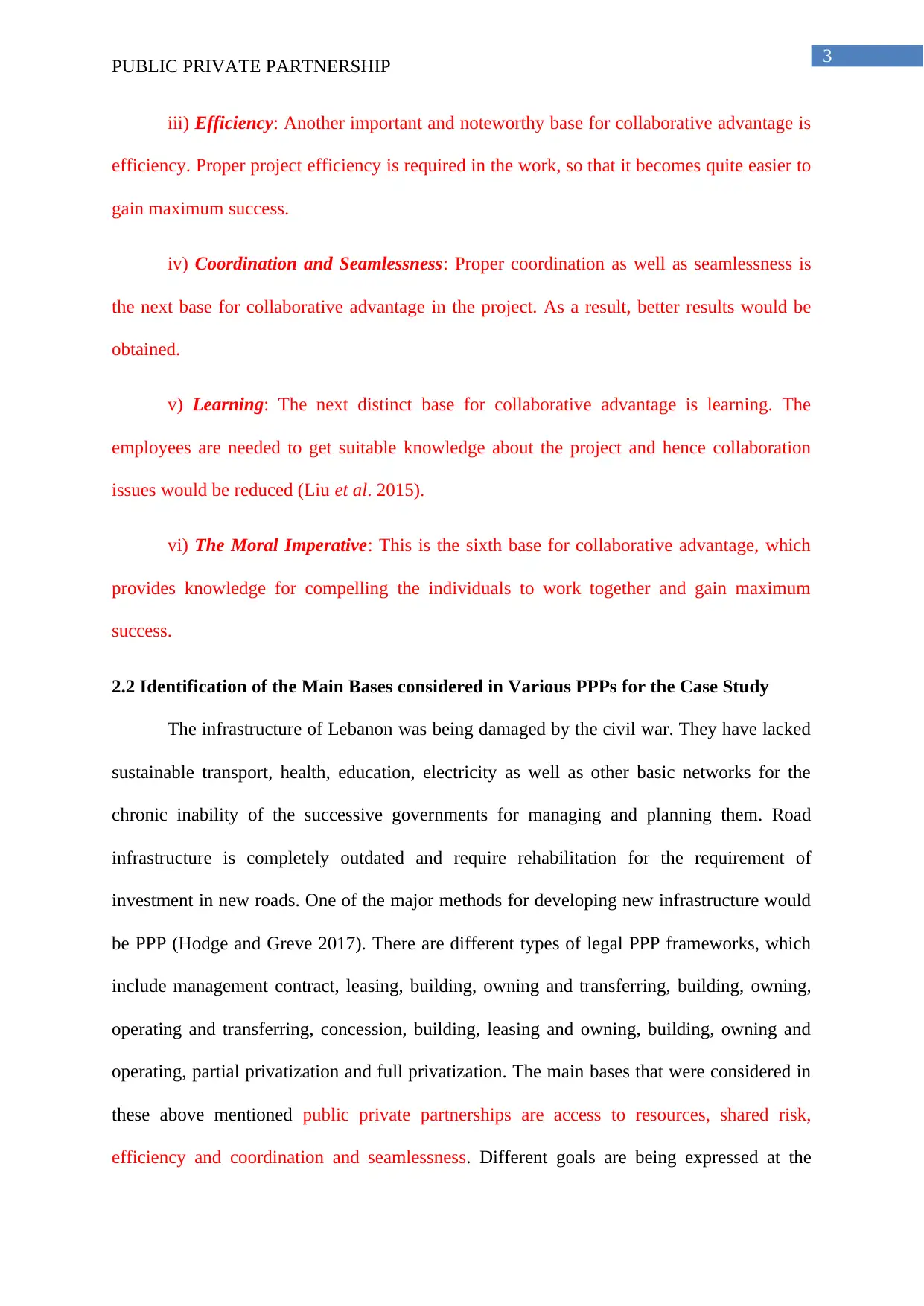
3
PUBLIC PRIVATE PARTNERSHIP
iii) Efficiency: Another important and noteworthy base for collaborative advantage is
efficiency. Proper project efficiency is required in the work, so that it becomes quite easier to
gain maximum success.
iv) Coordination and Seamlessness: Proper coordination as well as seamlessness is
the next base for collaborative advantage in the project. As a result, better results would be
obtained.
v) Learning: The next distinct base for collaborative advantage is learning. The
employees are needed to get suitable knowledge about the project and hence collaboration
issues would be reduced (Liu et al. 2015).
vi) The Moral Imperative: This is the sixth base for collaborative advantage, which
provides knowledge for compelling the individuals to work together and gain maximum
success.
2.2 Identification of the Main Bases considered in Various PPPs for the Case Study
The infrastructure of Lebanon was being damaged by the civil war. They have lacked
sustainable transport, health, education, electricity as well as other basic networks for the
chronic inability of the successive governments for managing and planning them. Road
infrastructure is completely outdated and require rehabilitation for the requirement of
investment in new roads. One of the major methods for developing new infrastructure would
be PPP (Hodge and Greve 2017). There are different types of legal PPP frameworks, which
include management contract, leasing, building, owning and transferring, building, owning,
operating and transferring, concession, building, leasing and owning, building, owning and
operating, partial privatization and full privatization. The main bases that were considered in
these above mentioned public private partnerships are access to resources, shared risk,
efficiency and coordination and seamlessness. Different goals are being expressed at the
PUBLIC PRIVATE PARTNERSHIP
iii) Efficiency: Another important and noteworthy base for collaborative advantage is
efficiency. Proper project efficiency is required in the work, so that it becomes quite easier to
gain maximum success.
iv) Coordination and Seamlessness: Proper coordination as well as seamlessness is
the next base for collaborative advantage in the project. As a result, better results would be
obtained.
v) Learning: The next distinct base for collaborative advantage is learning. The
employees are needed to get suitable knowledge about the project and hence collaboration
issues would be reduced (Liu et al. 2015).
vi) The Moral Imperative: This is the sixth base for collaborative advantage, which
provides knowledge for compelling the individuals to work together and gain maximum
success.
2.2 Identification of the Main Bases considered in Various PPPs for the Case Study
The infrastructure of Lebanon was being damaged by the civil war. They have lacked
sustainable transport, health, education, electricity as well as other basic networks for the
chronic inability of the successive governments for managing and planning them. Road
infrastructure is completely outdated and require rehabilitation for the requirement of
investment in new roads. One of the major methods for developing new infrastructure would
be PPP (Hodge and Greve 2017). There are different types of legal PPP frameworks, which
include management contract, leasing, building, owning and transferring, building, owning,
operating and transferring, concession, building, leasing and owning, building, owning and
operating, partial privatization and full privatization. The main bases that were considered in
these above mentioned public private partnerships are access to resources, shared risk,
efficiency and coordination and seamlessness. Different goals are being expressed at the
Secure Best Marks with AI Grader
Need help grading? Try our AI Grader for instant feedback on your assignments.
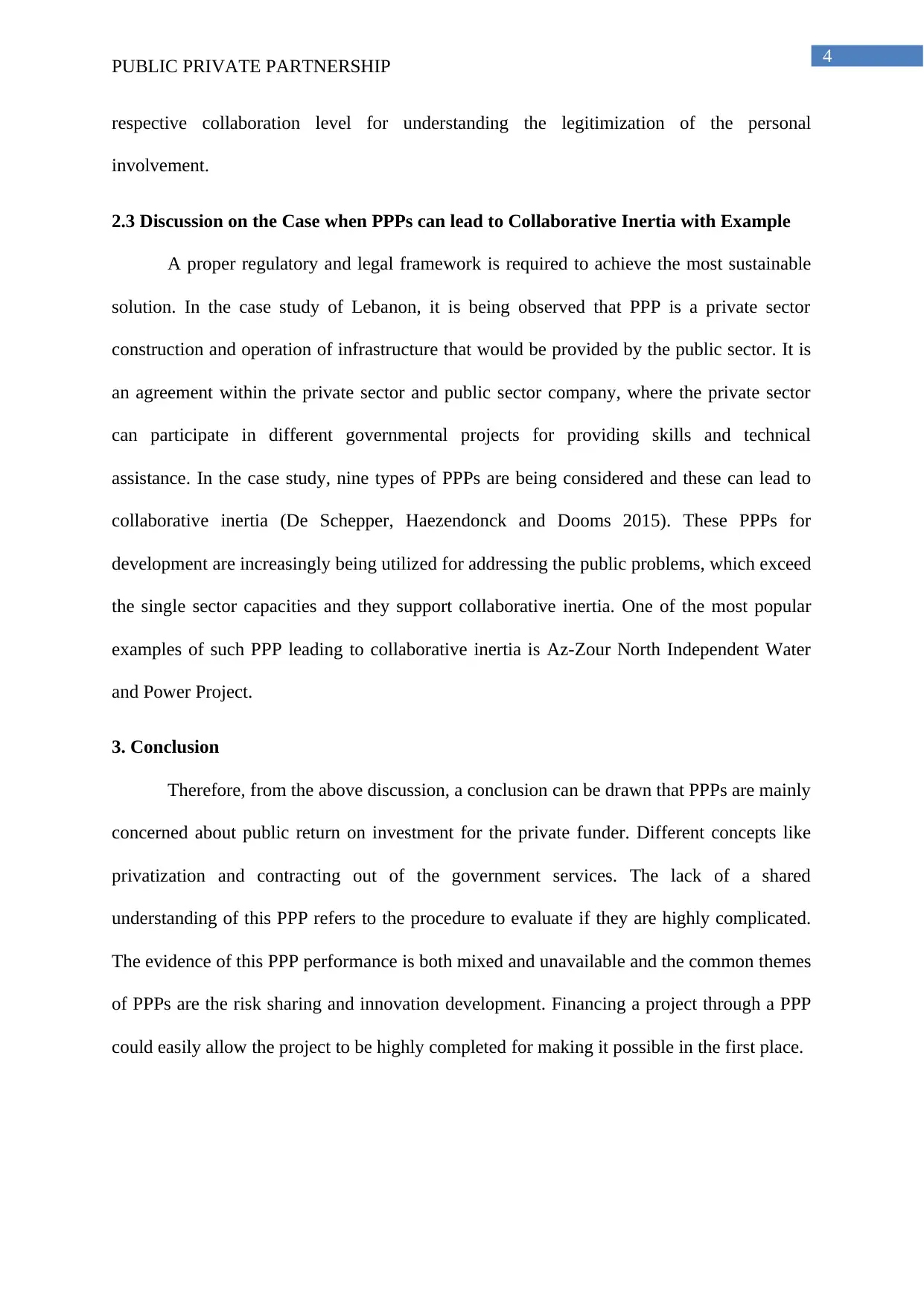
4
PUBLIC PRIVATE PARTNERSHIP
respective collaboration level for understanding the legitimization of the personal
involvement.
2.3 Discussion on the Case when PPPs can lead to Collaborative Inertia with Example
A proper regulatory and legal framework is required to achieve the most sustainable
solution. In the case study of Lebanon, it is being observed that PPP is a private sector
construction and operation of infrastructure that would be provided by the public sector. It is
an agreement within the private sector and public sector company, where the private sector
can participate in different governmental projects for providing skills and technical
assistance. In the case study, nine types of PPPs are being considered and these can lead to
collaborative inertia (De Schepper, Haezendonck and Dooms 2015). These PPPs for
development are increasingly being utilized for addressing the public problems, which exceed
the single sector capacities and they support collaborative inertia. One of the most popular
examples of such PPP leading to collaborative inertia is Az-Zour North Independent Water
and Power Project.
3. Conclusion
Therefore, from the above discussion, a conclusion can be drawn that PPPs are mainly
concerned about public return on investment for the private funder. Different concepts like
privatization and contracting out of the government services. The lack of a shared
understanding of this PPP refers to the procedure to evaluate if they are highly complicated.
The evidence of this PPP performance is both mixed and unavailable and the common themes
of PPPs are the risk sharing and innovation development. Financing a project through a PPP
could easily allow the project to be highly completed for making it possible in the first place.
PUBLIC PRIVATE PARTNERSHIP
respective collaboration level for understanding the legitimization of the personal
involvement.
2.3 Discussion on the Case when PPPs can lead to Collaborative Inertia with Example
A proper regulatory and legal framework is required to achieve the most sustainable
solution. In the case study of Lebanon, it is being observed that PPP is a private sector
construction and operation of infrastructure that would be provided by the public sector. It is
an agreement within the private sector and public sector company, where the private sector
can participate in different governmental projects for providing skills and technical
assistance. In the case study, nine types of PPPs are being considered and these can lead to
collaborative inertia (De Schepper, Haezendonck and Dooms 2015). These PPPs for
development are increasingly being utilized for addressing the public problems, which exceed
the single sector capacities and they support collaborative inertia. One of the most popular
examples of such PPP leading to collaborative inertia is Az-Zour North Independent Water
and Power Project.
3. Conclusion
Therefore, from the above discussion, a conclusion can be drawn that PPPs are mainly
concerned about public return on investment for the private funder. Different concepts like
privatization and contracting out of the government services. The lack of a shared
understanding of this PPP refers to the procedure to evaluate if they are highly complicated.
The evidence of this PPP performance is both mixed and unavailable and the common themes
of PPPs are the risk sharing and innovation development. Financing a project through a PPP
could easily allow the project to be highly completed for making it possible in the first place.
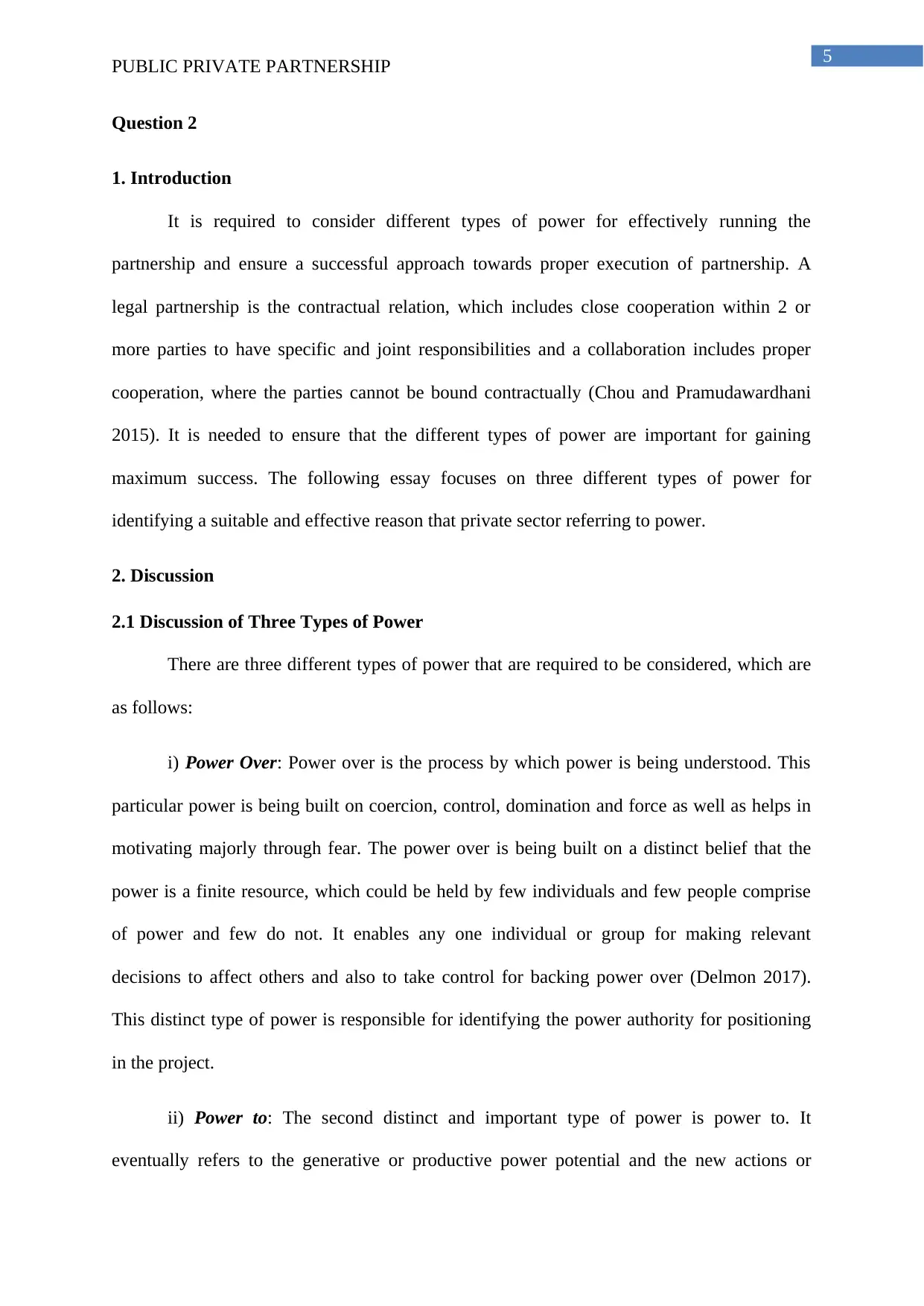
5
PUBLIC PRIVATE PARTNERSHIP
Question 2
1. Introduction
It is required to consider different types of power for effectively running the
partnership and ensure a successful approach towards proper execution of partnership. A
legal partnership is the contractual relation, which includes close cooperation within 2 or
more parties to have specific and joint responsibilities and a collaboration includes proper
cooperation, where the parties cannot be bound contractually (Chou and Pramudawardhani
2015). It is needed to ensure that the different types of power are important for gaining
maximum success. The following essay focuses on three different types of power for
identifying a suitable and effective reason that private sector referring to power.
2. Discussion
2.1 Discussion of Three Types of Power
There are three different types of power that are required to be considered, which are
as follows:
i) Power Over: Power over is the process by which power is being understood. This
particular power is being built on coercion, control, domination and force as well as helps in
motivating majorly through fear. The power over is being built on a distinct belief that the
power is a finite resource, which could be held by few individuals and few people comprise
of power and few do not. It enables any one individual or group for making relevant
decisions to affect others and also to take control for backing power over (Delmon 2017).
This distinct type of power is responsible for identifying the power authority for positioning
in the project.
ii) Power to: The second distinct and important type of power is power to. It
eventually refers to the generative or productive power potential and the new actions or
PUBLIC PRIVATE PARTNERSHIP
Question 2
1. Introduction
It is required to consider different types of power for effectively running the
partnership and ensure a successful approach towards proper execution of partnership. A
legal partnership is the contractual relation, which includes close cooperation within 2 or
more parties to have specific and joint responsibilities and a collaboration includes proper
cooperation, where the parties cannot be bound contractually (Chou and Pramudawardhani
2015). It is needed to ensure that the different types of power are important for gaining
maximum success. The following essay focuses on three different types of power for
identifying a suitable and effective reason that private sector referring to power.
2. Discussion
2.1 Discussion of Three Types of Power
There are three different types of power that are required to be considered, which are
as follows:
i) Power Over: Power over is the process by which power is being understood. This
particular power is being built on coercion, control, domination and force as well as helps in
motivating majorly through fear. The power over is being built on a distinct belief that the
power is a finite resource, which could be held by few individuals and few people comprise
of power and few do not. It enables any one individual or group for making relevant
decisions to affect others and also to take control for backing power over (Delmon 2017).
This distinct type of power is responsible for identifying the power authority for positioning
in the project.
ii) Power to: The second distinct and important type of power is power to. It
eventually refers to the generative or productive power potential and the new actions or
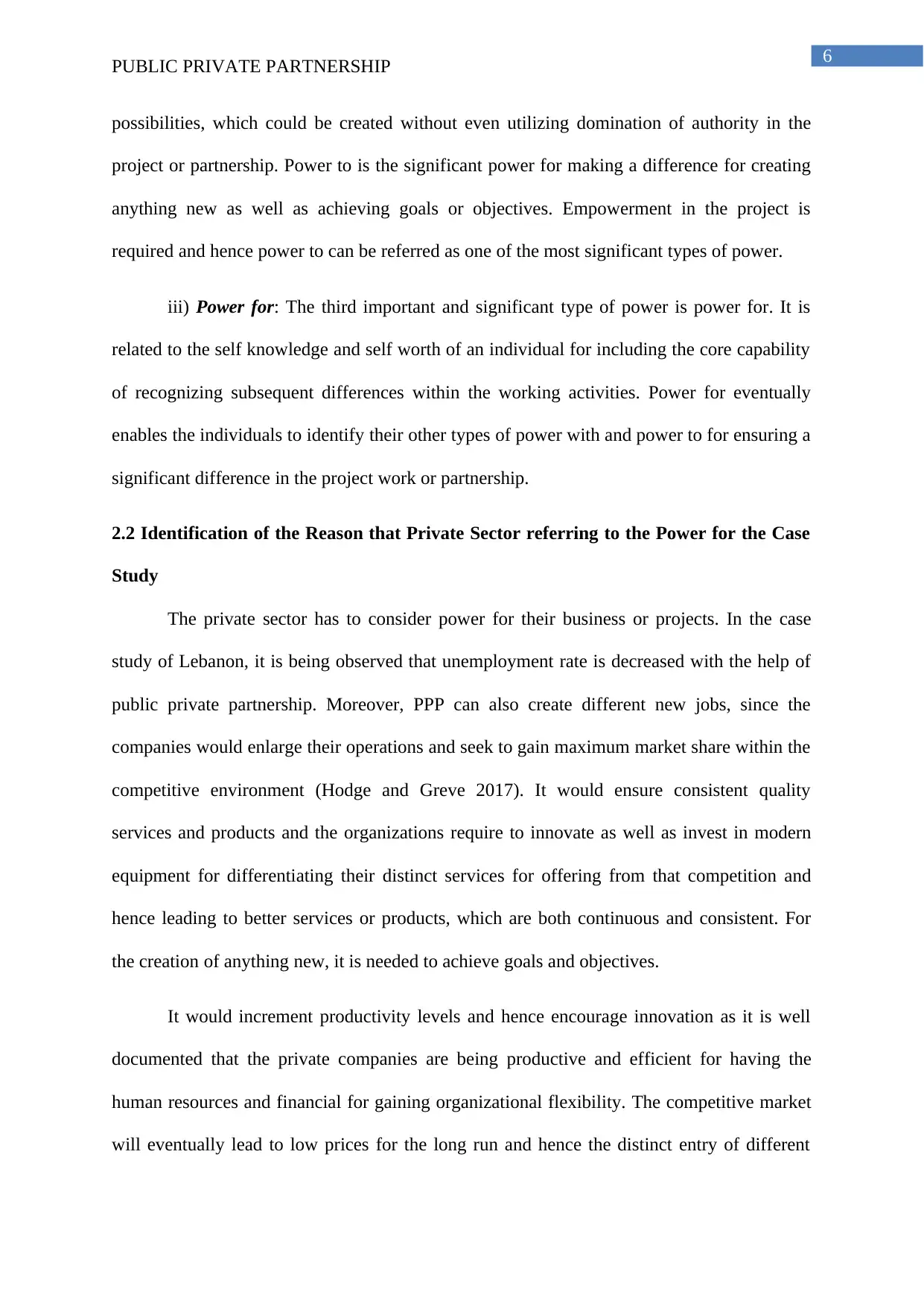
6
PUBLIC PRIVATE PARTNERSHIP
possibilities, which could be created without even utilizing domination of authority in the
project or partnership. Power to is the significant power for making a difference for creating
anything new as well as achieving goals or objectives. Empowerment in the project is
required and hence power to can be referred as one of the most significant types of power.
iii) Power for: The third important and significant type of power is power for. It is
related to the self knowledge and self worth of an individual for including the core capability
of recognizing subsequent differences within the working activities. Power for eventually
enables the individuals to identify their other types of power with and power to for ensuring a
significant difference in the project work or partnership.
2.2 Identification of the Reason that Private Sector referring to the Power for the Case
Study
The private sector has to consider power for their business or projects. In the case
study of Lebanon, it is being observed that unemployment rate is decreased with the help of
public private partnership. Moreover, PPP can also create different new jobs, since the
companies would enlarge their operations and seek to gain maximum market share within the
competitive environment (Hodge and Greve 2017). It would ensure consistent quality
services and products and the organizations require to innovate as well as invest in modern
equipment for differentiating their distinct services for offering from that competition and
hence leading to better services or products, which are both continuous and consistent. For
the creation of anything new, it is needed to achieve goals and objectives.
It would increment productivity levels and hence encourage innovation as it is well
documented that the private companies are being productive and efficient for having the
human resources and financial for gaining organizational flexibility. The competitive market
will eventually lead to low prices for the long run and hence the distinct entry of different
PUBLIC PRIVATE PARTNERSHIP
possibilities, which could be created without even utilizing domination of authority in the
project or partnership. Power to is the significant power for making a difference for creating
anything new as well as achieving goals or objectives. Empowerment in the project is
required and hence power to can be referred as one of the most significant types of power.
iii) Power for: The third important and significant type of power is power for. It is
related to the self knowledge and self worth of an individual for including the core capability
of recognizing subsequent differences within the working activities. Power for eventually
enables the individuals to identify their other types of power with and power to for ensuring a
significant difference in the project work or partnership.
2.2 Identification of the Reason that Private Sector referring to the Power for the Case
Study
The private sector has to consider power for their business or projects. In the case
study of Lebanon, it is being observed that unemployment rate is decreased with the help of
public private partnership. Moreover, PPP can also create different new jobs, since the
companies would enlarge their operations and seek to gain maximum market share within the
competitive environment (Hodge and Greve 2017). It would ensure consistent quality
services and products and the organizations require to innovate as well as invest in modern
equipment for differentiating their distinct services for offering from that competition and
hence leading to better services or products, which are both continuous and consistent. For
the creation of anything new, it is needed to achieve goals and objectives.
It would increment productivity levels and hence encourage innovation as it is well
documented that the private companies are being productive and efficient for having the
human resources and financial for gaining organizational flexibility. The competitive market
will eventually lead to low prices for the long run and hence the distinct entry of different
Paraphrase This Document
Need a fresh take? Get an instant paraphrase of this document with our AI Paraphraser
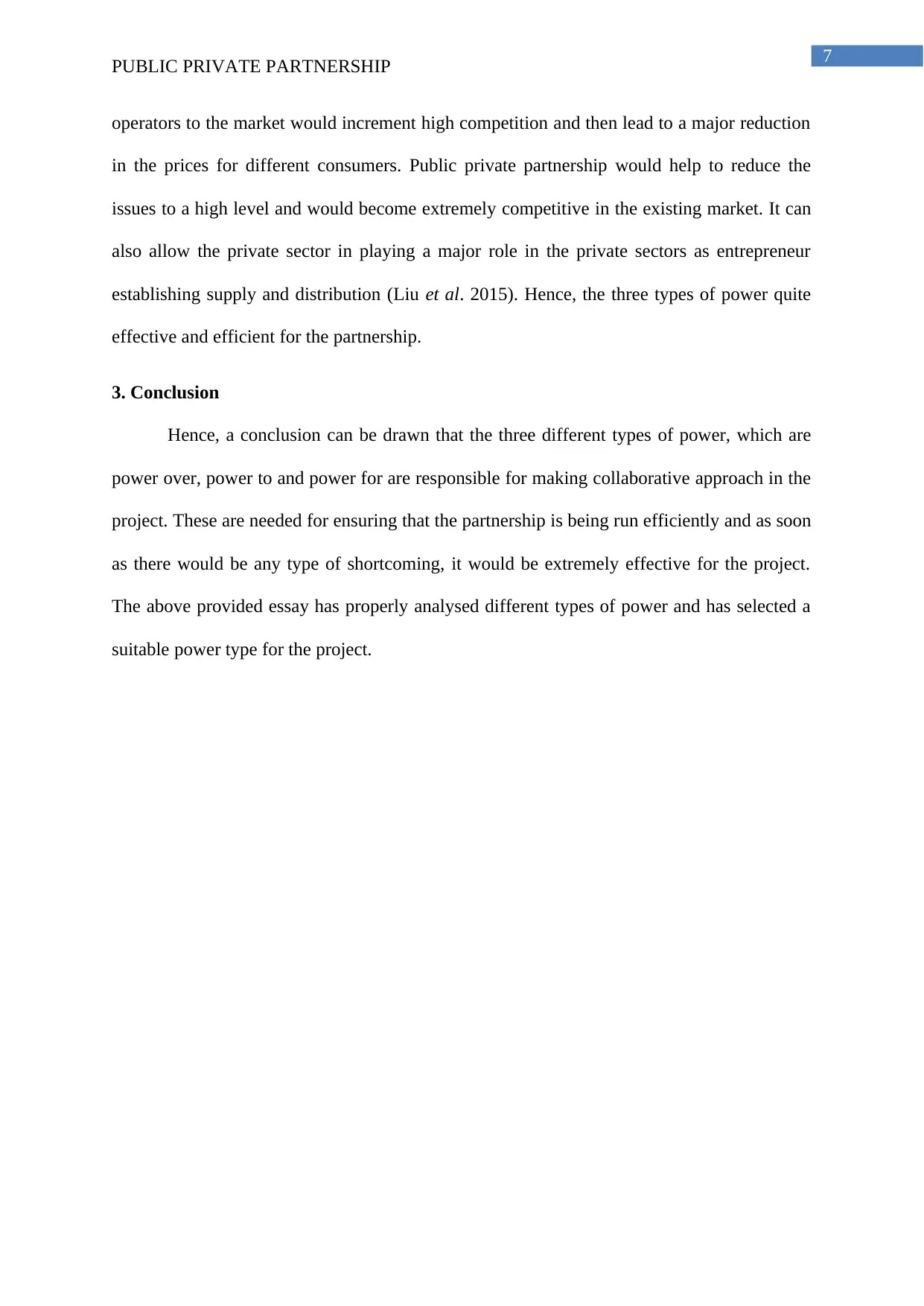
7
PUBLIC PRIVATE PARTNERSHIP
operators to the market would increment high competition and then lead to a major reduction
in the prices for different consumers. Public private partnership would help to reduce the
issues to a high level and would become extremely competitive in the existing market. It can
also allow the private sector in playing a major role in the private sectors as entrepreneur
establishing supply and distribution (Liu et al. 2015). Hence, the three types of power quite
effective and efficient for the partnership.
3. Conclusion
Hence, a conclusion can be drawn that the three different types of power, which are
power over, power to and power for are responsible for making collaborative approach in the
project. These are needed for ensuring that the partnership is being run efficiently and as soon
as there would be any type of shortcoming, it would be extremely effective for the project.
The above provided essay has properly analysed different types of power and has selected a
suitable power type for the project.
PUBLIC PRIVATE PARTNERSHIP
operators to the market would increment high competition and then lead to a major reduction
in the prices for different consumers. Public private partnership would help to reduce the
issues to a high level and would become extremely competitive in the existing market. It can
also allow the private sector in playing a major role in the private sectors as entrepreneur
establishing supply and distribution (Liu et al. 2015). Hence, the three types of power quite
effective and efficient for the partnership.
3. Conclusion
Hence, a conclusion can be drawn that the three different types of power, which are
power over, power to and power for are responsible for making collaborative approach in the
project. These are needed for ensuring that the partnership is being run efficiently and as soon
as there would be any type of shortcoming, it would be extremely effective for the project.
The above provided essay has properly analysed different types of power and has selected a
suitable power type for the project.
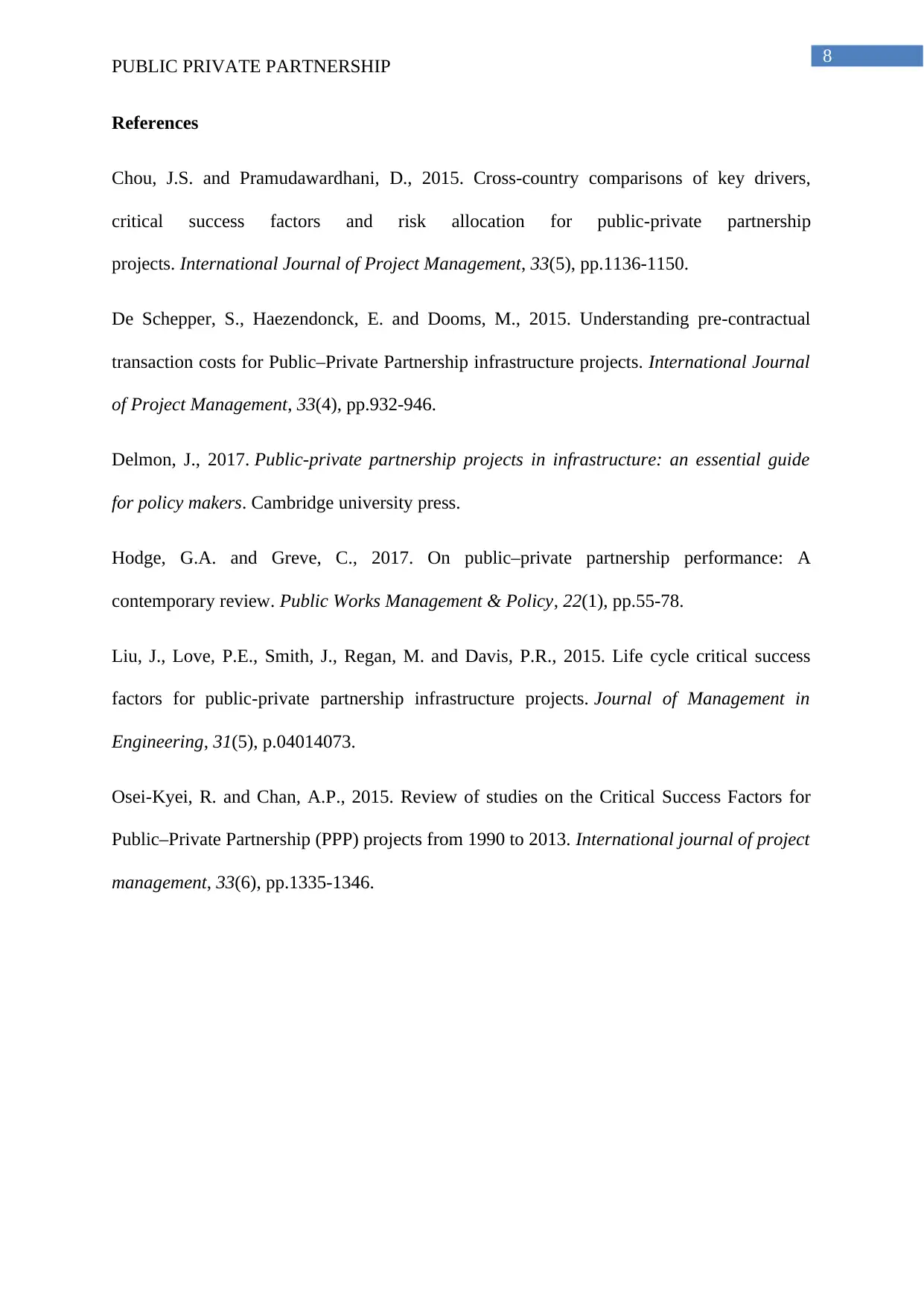
8
PUBLIC PRIVATE PARTNERSHIP
References
Chou, J.S. and Pramudawardhani, D., 2015. Cross-country comparisons of key drivers,
critical success factors and risk allocation for public-private partnership
projects. International Journal of Project Management, 33(5), pp.1136-1150.
De Schepper, S., Haezendonck, E. and Dooms, M., 2015. Understanding pre-contractual
transaction costs for Public–Private Partnership infrastructure projects. International Journal
of Project Management, 33(4), pp.932-946.
Delmon, J., 2017. Public-private partnership projects in infrastructure: an essential guide
for policy makers. Cambridge university press.
Hodge, G.A. and Greve, C., 2017. On public–private partnership performance: A
contemporary review. Public Works Management & Policy, 22(1), pp.55-78.
Liu, J., Love, P.E., Smith, J., Regan, M. and Davis, P.R., 2015. Life cycle critical success
factors for public-private partnership infrastructure projects. Journal of Management in
Engineering, 31(5), p.04014073.
Osei-Kyei, R. and Chan, A.P., 2015. Review of studies on the Critical Success Factors for
Public–Private Partnership (PPP) projects from 1990 to 2013. International journal of project
management, 33(6), pp.1335-1346.
PUBLIC PRIVATE PARTNERSHIP
References
Chou, J.S. and Pramudawardhani, D., 2015. Cross-country comparisons of key drivers,
critical success factors and risk allocation for public-private partnership
projects. International Journal of Project Management, 33(5), pp.1136-1150.
De Schepper, S., Haezendonck, E. and Dooms, M., 2015. Understanding pre-contractual
transaction costs for Public–Private Partnership infrastructure projects. International Journal
of Project Management, 33(4), pp.932-946.
Delmon, J., 2017. Public-private partnership projects in infrastructure: an essential guide
for policy makers. Cambridge university press.
Hodge, G.A. and Greve, C., 2017. On public–private partnership performance: A
contemporary review. Public Works Management & Policy, 22(1), pp.55-78.
Liu, J., Love, P.E., Smith, J., Regan, M. and Davis, P.R., 2015. Life cycle critical success
factors for public-private partnership infrastructure projects. Journal of Management in
Engineering, 31(5), p.04014073.
Osei-Kyei, R. and Chan, A.P., 2015. Review of studies on the Critical Success Factors for
Public–Private Partnership (PPP) projects from 1990 to 2013. International journal of project
management, 33(6), pp.1335-1346.
1 out of 9
Related Documents
Your All-in-One AI-Powered Toolkit for Academic Success.
+13062052269
info@desklib.com
Available 24*7 on WhatsApp / Email
![[object Object]](/_next/static/media/star-bottom.7253800d.svg)
Unlock your academic potential
© 2024 | Zucol Services PVT LTD | All rights reserved.





